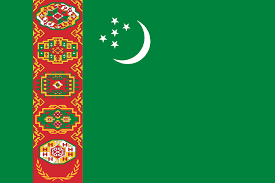Language/Turkmen/Vocabulary/Directions-and-Locations
| ◀️ Modes of Transportation — Previous Lesson | Next Lesson — Regions of Turkmenistan ▶️ |
Introduction[edit | edit source]
In this lesson, we will learn how to ask for and give directions in Turkmen. Being able to navigate and understand directions is essential when traveling or exploring a new place. By the end of this lesson, you will be able to confidently ask for directions and understand the responses in Turkmen. We will cover vocabulary related to directions, locations, and landmarks, and practice through various exercises and scenarios.
Vocabulary[edit | edit source]
Basic Directions[edit | edit source]
Let's start by learning some basic words for directions in Turkmen:
| Turkmen | Pronunciation | English |
|---|---|---|
| ýagdaý | yagday | left |
| ýokary | yokary | up |
| öňe | önje | ahead |
| sagadyň | sagadyn | right |
| aşak | ashak | down |
| garaşmak | garashmak | to wait |
| ýola çykmak | yola chykmak | to go out |
| galmak | galymak | to stay |
| gelmek | gelmek | to come |
| gitmek | gitmek | to go |
Now, let's see these words in action:
- "Garaşmak" means "to wait". You can use it to say "Wait here" which is "Şu ýerde garaş" in Turkmen. - "Ýola çykmak" means "to go out". You can use it to say "Go out of the building" which is "Binygyn ýola çyk" in Turkmen. - "Gelmek" means "to come". You can use it to say "Come with me" which is "Men bilen gel" in Turkmen. - "Gitmek" means "to go". You can use it to say "Go straight" which is "Düz git" in Turkmen.
Asking for Directions[edit | edit source]
To ask for directions in Turkmen, you can use the following phrases:
- "Nirede?" - This means "Where?" You can use it to ask for a specific location, like "Nirede bazar?" which means "Where is the market?" - "Nire gitmeli?" - This means "Where should I go?" You can use it to ask for directions to a specific place, like "Nire gitmeli ýylyň ýakasy?" which means "Where should I go to the beach?" - "Nirede ýaşapdyňyz?" - This means "Where do you live?" You can use it to ask for someone's address.
Giving Directions[edit | edit source]
To give directions in Turkmen, you can use the following phrases:
- "Ýagdaý" - This means "left". You can use it to say "Turn left" which is "Ýagdaý dönmek" in Turkmen. - "Sagadyň" - This means "right". You can use it to say "Turn right" which is "Sagadyň dönmek" in Turkmen. - "Öňe" - This means "ahead". You can use it to say "Go straight" which is "Öňe gitmek" in Turkmen. - "Ýokary" - This means "up". You can use it to say "Go up the stairs" which is "Merdivenleri ýokary gitmek" in Turkmen. - "Aşak" - This means "down". You can use it to say "Go down the hill" which is "Tepeden aşak gitmek" in Turkmen.
Remember to combine these words and phrases to give clear and accurate directions.
Cultural Insights[edit | edit source]
In Turkmenistan, directions are often given based on landmarks and well-known locations rather than street names. This is because street names are not widely used or recognized. Instead, Turkmen people rely on landmarks, such as buildings, monuments, or natural features, to provide directions. For example, someone might say "Turn left at the mosque" or "Go straight until you reach the big park".
Additionally, it is common for Turkmen people to give directions using distances and time rather than specific directions. For example, they might say "Go straight for about 500 meters" or "Turn right after 10 minutes". This is because Turkmenistan is a vast country with wide-open spaces, and distances between locations can be significant.
It's also worth noting that Turkmenistan has a unique system of numbering buildings. Instead of using consecutive numbers, buildings are often numbered based on their location within a block or neighborhood. For example, a building might be numbered as "10/2", indicating that it is the second building on the left side of the street.
Practice Exercises[edit | edit source]
Now, let's practice what we've learned through some exercises:
Exercise 1: Fill in the Blanks
Complete the following sentences with the appropriate Turkmen words for directions:
1. Turn __________ at the traffic light. 2. Go __________ for about 200 meters. 3. The museum is __________ the street. 4. The park is __________ the hill. 5. You need to go __________ the bridge.
Exercise 1: Solutions
1. Turn __right__ at the traffic light. 2. Go __straight__ for about 200 meters. 3. The museum is __across__ the street. 4. The park is __down__ the hill. 5. You need to go __over__ the bridge.
Exercise 2: Dialogue Practice
Work in pairs and practice the following dialogue:
Person A: Nirede bazar? Person B: Bazar ýokaryda. Ýola çykmalyňyz, sagadyň dönmeli ýagdaýda. Person A: Sagbol, ýokary gitjek. Person B: Garaşmak üçin, ýokaryda ýaraňyşyk ýeri bar. Person A: Galmak bilen garaşar.
Exercise 2: Dialogue Practice - Translation
Person A: Where is the market? Person B: The market is up. You should go out and turn right at the intersection. Person A: Thank you, I'll go up. Person B: To wait, there is a bench up there. Person A: I'll stay and wait.
Conclusion[edit | edit source]
Congratulations! You have learned how to ask for and give directions in Turkmen. This is an essential skill when traveling or exploring Turkmenistan. Remember to use the vocabulary and phrases we've covered in this lesson to confidently navigate and understand directions. Keep practicing and exploring the beautiful country of Turkmenistan!
Other Lessons[edit | edit source]
- Common Hobbies
- Basic Turkmen Phrases
- Body
- Vegetables
- Modes of Transportation
- Nature
- House
- Education
- Transport
| ◀️ Modes of Transportation — Previous Lesson | Next Lesson — Regions of Turkmenistan ▶️ |

